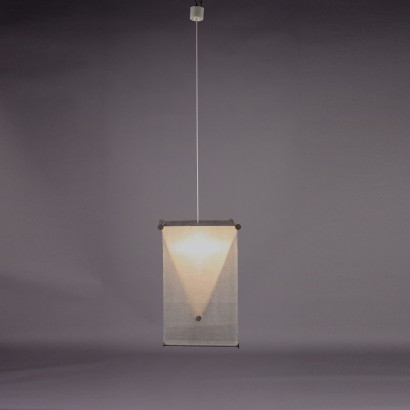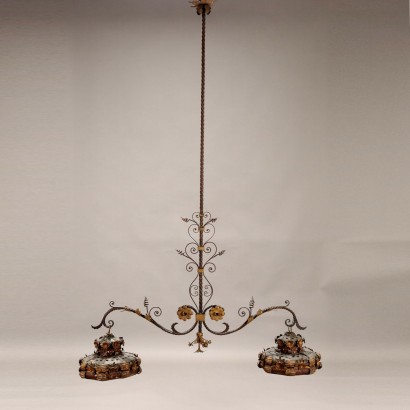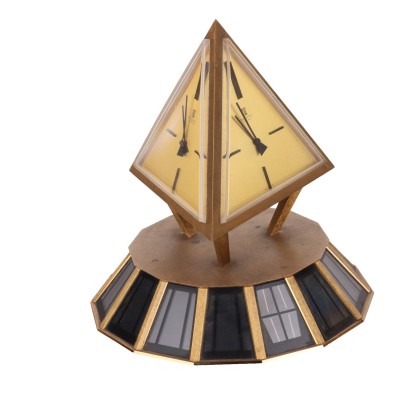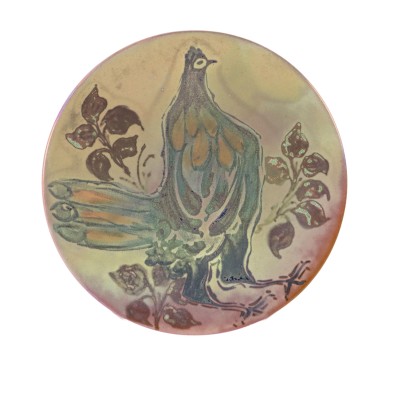Vintage 1970s Lamp Flos Teli 374 Design Achille Castiglioni
Features
Designer: Achille Castiglioni
Production: Flos
Model: Teli 374
Production country: Italy
Material: Synthetic material
Description
Ceiling lamp with sheets of synthetic material called "Raflon".
Product Condition:
Lamp in good condition, has small signs of wear. We try to present the real state of the lamps as fully as possible with photos. If some details are not clear from the photos, what is stated in the description applies.
Dimensions (cm):
Height: 62
Width: 42
Depth: 39
Maximum size (cm):
Height: 177
Additional Information
Designer: Achille Castiglioni
Achille Castiglioni (1918 - 2002), the only Italian architect and designer to whom the MoMA in New York has so far dedicated a retrospective. He completed his studies at the Milan Polytechnic in 1944. He was an all-round designer, involved in urban planning, architecture, exhibitions, exhibitions, and product design projects. In 1956 he helped found the Italian Association of Industrial Design (ADI). In the years 1952-1953 he worked on the reconstruction of the Palazzo della Permanente in Milan. Between 1955 and 1979 he won seven Compasso d'Oro awards, the last one for the Parentesi lamp designed with Pio Manzù. He was awarded multiple awards at the Triennale: Bronze Medal in 1947, Grand Prix in 1951 and 1954, Silver and Gold Medal in 1957, Gold Medal in 1960 and Silver again in 1963. From 1971 he began his career as a professor at the Faculty of Architecture of the Polytechnic of Turin. His signature in the modern antiques, together with that of his brother Pier Giacomo, can be found on various production objects for many brands, such as Kartell, Zanotta, Flos, Bernini, Siemens, Knoll, Poggi, Lancia, Alessi, Ideal Standard, Arflex.Find out more about Achille Castiglioni with our insights:
Parentesi lamp, freedom on cable
Arco Lamp, Icon among the Icons
Production: Flos
At the origin of Flos there is first of all a luminous idea, the thought that from a light bulb, or rather from a new idea of how to draw artificial light, objects could be born that could change the way of life of the people. Italians: population as we know very spoiled by being born, raised and lived in a territory where at every step they stumble into something that has to do with art. At the end of the 50s a gentleman called Dino Gavina, a very individualistic gentleman and almost possessed by the idea that Italy should be the new home of a new furniture culture, after having met the inventor and small producer from Merano Arturo Eisenkeil took it into his head that after creating many new furniture (with Achille and Pier Giacomo Castiglioni, Ignazio Gardella, Carlo and Tobia Scarpa and other geniuses of Italian architecture), the time had come to create new lamps. The cocoon technique used by Eisenkeil, a resin sprayed on a metal frame, seemed perfect to begin with: it was not a question of decorating a light bulb, but of giving magic to the light that came from it filtering through a hazy but therefore fascinating material, such as are the clouds. Soon the cocoon technique was followed by many others, beautiful and still very surprising for that country still so tied to old ideas of furniture: so that, like it or not, already from its prehistory Flos (i.e. the company with the invented name by Pier Giacomo Castiglioni, who succeeded Eisenkeil) found itself in that interesting, sometimes uncomfortable position of someone who is obliged to continually produce objects of invention. In 1966 a new phase opens with the passage of the company from the artistic management of Dino Gavina to the more entrepreneurial one of Sergio Gandini. Already engaged since 1959 in furnishing with his wife Piera in the Stile store in Brescia (a space that is already a point of reference for many companies in the sector), when Flos moved to his city, to exploit the historical expertise of what Today it would be called an industrial district for metalworking, Gandini was soon involved as a partner in the company by Gavina himself and by Cesare Cassina. Afra and Tobia Scarpa and the Castiglioni brothers, since then and for many years to come, will be the creative soul of the entire Flos production. In the case of Flos, the encounter with the two Castiglioni brothers is certainly fortunate, first, and then with Achille alone, upon Pier Giacomo's premature death in 1968. Inventors more than architects, artists as well as designers, are able to assemble existing industrial components (as in the Toio, or in the Mezzadro stool for Zanotta) or invented (as in the Arco, the Splugen, the Black and White or the Parentesi, designed in 1969. with Pio Manzù) to create new kinds of artificial lighting, with an immediacy of form and meaning difficult to find in other designers. Even more exemplary is the harmony that is created between them and Sergio Gandini, when he calls them to be jointly responsible for all product choices. It is no longer just a question of creating an important object, a formal sign of great mastery, but of designing its entire life cycle in production and on the market, up to its final use. The beautiful utopia of the object that necessarily meets the public's taste only for the skill of the designer is overcome by a concrete realism, which makes Gandini, Castiglioni and Scarpa work together on problems such as packaging, graphics, storage, distribution, with the same commitment dedicated to the study of light or the material of the product. The first foreign company was opened in Germany in 1971, while 1973 was the year of the expansion of the plant (from 800 to 5400 square meters) and of the acquisition of Arteluce: the one-man-company of Gino Sarfatti, one of the most great Italian talents in the lighting design, author since the 40s of excellent pieces but then linked to a dimension of the product and of the supply still to a large extent. With the collaboration of Paolo Rizzatto, then a novice designer, and Marco Pezzolo as director, Gandini began to reprogram the catalog: he kept a few original iconic pieces by Sarfatti, generating over time with designers such as King Miranda and Arnaldi, Ezio Didone, Marc Sadler, Matteo Thun, Rizzatto himself, a series of very successful and commercially important new products. The real strategic change, however, takes place with the arrival of Philippe Starck, who begins the collaboration with Arà (1988), a curious adjustable horn lamp that reflects the fabulous imagery of an author launched towards extreme popularity. Piero Gandini has already sensed the commercial possibilities of Starck's work and gladly accepts when he, now well-known as an interior designer, proposes to mass-produce a small plastic object imagined for a New York hotel: Miss Sissi, a sort of icon of 'abat-jour, "What everybody thinks in their unconscious a lamp is", "What everyone in their unconscious thinks like a lamp" Starck would say in one of his lectures years later. Sergio Gandini initially had some doubts, but in 1991 the project went into production and was an incredible success. With the 90s the slow decline of the incandescent lamp continues, which yields to the invasion of the low energy consumption one, while the LED one begins to take shape as a real revolution.Time:
1970s
1970s1980s
1980sMaterial: Synthetic material
Other customers have searched:
Lampadari modernariato, lampadario modernariato, lampada a soffitto design, lampadari design, lampada a soffitto..
Approfondimenti
Se vuoi conoscere qualcosa in più sul mondo dei lampadari di modernariato, consulta gli approfondimenti del nostro blog e le presentazioni di FineArt:
Che cos'è il vetro opalino
Il lampadario Maria Teresa, un grande classico dell'illuminazione
Due epoche per un lampadario dal gustounico
Lampadari Neoclassici Eleganti per Ricevimenti
Le Icone del design:
Lampada Parentesi: libertà su cavo
Pistillino: la natura che incontra il design
Esempi di abbinamento di lampadari di modernariato con altri arredi, su Corner MiX:
Corner MiX n.1
Corner MiX n.4
Corner MiX n.3
Corner MiX n.6
Corner MiX n.8
Corner MiX n.11
Corner MiX n.12
Corner MiX n.15
Corner MiX n.5
Corner MiX n.7
Corner MiX n.10
Corner MiX n.13
Corner MiX n.2
Corner MiX n.9
Corner MiX n.16
Corner MiX n.14
FineArt:
Tutta l'illuminazione by FineArt
Lampada '2259/2', Max Ingrand per FontanaArte
Lampadario barocco inizi XVIII secolo
Lampadario – O. Lelièvre & Susse Frères, Parigi, ultimo quarto XIX secolo
Lampadario Regency, Inghilterra, 1820 ca.
Lampadario anni '40 Manifattura Italiana
Lampadario Impero a Mongolfiera, primo quarto XIX secolo
Lampadario Inglese, prima metà XIX secolo
Lampadario 'Giogali', Angelo Mangiarotti per Vistosi
Biedermeier Reifenluster, Vienna, 1820-1830 ca.
Lampada da terra 'Prisma LTE12', Ignazio Gardella per Azucena
Lampada 'Pugnali' Piero Fornasetti
Lampada Magnolia di Sergio Mazza e Giuliana Gramigna per Quattrifolio
Sul modernariato in generale
From the Sixties to the Sixteenth Century – From the Sixteenth Century to the Sixties
Sedute design
Le sedute e la nascita del design
Sacco - la poltrona trasformista
Valigia - la lampada da viaggio
Pistillino - la natura che incontra il design
Eames lounge chair
Tizio by Artemide - l'equilibrio del movimento
Come dare un look mid century alla propria casa
Design scandinavo vs Design Italiano
Alla scoperta del modernariato
Approfondimenti
Se vuoi conoscere qualcosa in più sul mondo dei lampadari di modernariato, consulta gli approfondimenti del nostro blog e le presentazioni di FineArt:Che cos'è il vetro opalino
Il lampadario Maria Teresa, un grande classico dell'illuminazione
Due epoche per un lampadario dal gustounico
Lampadari Neoclassici Eleganti per Ricevimenti
Le Icone del design:
Lampada Parentesi: libertà su cavo
Pistillino: la natura che incontra il design
Esempi di abbinamento di lampadari di modernariato con altri arredi, su Corner MiX:
Corner MiX n.1
Corner MiX n.4
Corner MiX n.3
Corner MiX n.6
Corner MiX n.8
Corner MiX n.11
Corner MiX n.12
Corner MiX n.15
Corner MiX n.5
Corner MiX n.7
Corner MiX n.10
Corner MiX n.13
Corner MiX n.2
Corner MiX n.9
Corner MiX n.16
Corner MiX n.14
FineArt:
Tutta l'illuminazione by FineArt
Lampada '2259/2', Max Ingrand per FontanaArte
Lampadario barocco inizi XVIII secolo
Lampadario – O. Lelièvre & Susse Frères, Parigi, ultimo quarto XIX secolo
Lampadario Regency, Inghilterra, 1820 ca.
Lampadario anni '40 Manifattura Italiana
Lampadario Impero a Mongolfiera, primo quarto XIX secolo
Lampadario Inglese, prima metà XIX secolo
Lampadario 'Giogali', Angelo Mangiarotti per Vistosi
Biedermeier Reifenluster, Vienna, 1820-1830 ca.
Lampada da terra 'Prisma LTE12', Ignazio Gardella per Azucena
Lampada 'Pugnali' Piero Fornasetti
Lampada Magnolia di Sergio Mazza e Giuliana Gramigna per Quattrifolio
Sul modernariato in generale
From the Sixties to the Sixteenth Century – From the Sixteenth Century to the Sixties
Sedute design
Le sedute e la nascita del design
Sacco - la poltrona trasformista
Valigia - la lampada da viaggio
Pistillino - la natura che incontra il design
Eames lounge chair
Tizio by Artemide - l'equilibrio del movimento
Come dare un look mid century alla propria casa
Design scandinavo vs Design Italiano
Alla scoperta del modernariato
Alternative proposals
It could also interest you










































